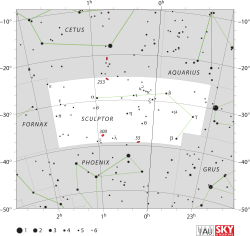Zeta Sculptoris
| Zeta Sculptoris (ζ) | |
 | |
| Observationsdata Epok: J2000.0 | |
|---|---|
| Stjärnbild | Bildhuggaren |
| Rektascension | 00t 02m 19,92035s[1] |
| Deklination | -29° 43′ 13,4873″[1] |
| Skenbar magnitud () | +5,04[2] |
| Stjärntyp | |
| Spektraltyp | B5 V[3] |
| U–B | -0,55[4] |
| B–V | -0,16[4] |
| Astrometri | |
| Radialhastighet () | +8,6 ± 1,6[5] km/s |
| Egenrörelse (µ) | RA: +9,34[1] mas/år Dek.: +14,50[1] mas/år |
| Parallax () | 9,49 ± 0,25[1] |
| Avstånd | 500 ± 20 lå (154 ± 6 pc) |
| Absolut magnitud () | -0,89[2] |
| Detaljer | |
| Massa | 5,5[6] M☉ |
| Radie | 3,5[7] R☉ |
| Luminositet | 496[2] L☉ |
| Temperatur | 16 100[3] K |
| Metallicitet | 0,00[8] dex |
| Vinkelhastighet | 15[9] km/s |
| Andra beteckningar | |
| ζ Scl, CD- 30° 19790, FK5 3932, GC 33337, HD 224990, HIP 183, HR 9091, SAO 135551, CCDM J00023-2943AB , WDS J00023-2943AB, GSC 06418-01221 | |
Zeta Sculptoris ( ζ Sculptoris, förkortat Zeta Scl, ζ Scl) som är stjärnans Bayerbeteckning, är en dubbelstjärna belägen i den mellersta delen av stjärnbilden Bildhuggaren. Den har en skenbar magnitud på 5,04[2] och är svagt synlig för blotta ögat där ljusföroreningar ej förekommer. Baserat på parallaxmätning inom Hipparcosuppdraget på ca 6,5[1] mas, beräknas den befinna sig på ett avstånd på ca 500 ljusår (ca 154 parsek) från solen och rör sig bort med en radiell hastighet på +8,6 km/s.[5] Zeta Sculptoris ligger nära den öppna stjärnhopen Blanco 1 sett från jorden, även om parallaxmätningar visar att denna befinner sig väsentligt närmare oss.[10]
Egenskaper[redigera | redigera wikitext]
Primärstjärnan Zeta Sculptoris A är en blåvit stjärna i huvudserien av spektralklass B5 V[3]. Den har en massa som är ca 5,5[6] gånger större än solens massa, en radie som är ca 3,5[7] gånger större än solens och utsänder från dess fotosfär ca 500[2] gånger mera energi än solen vid en effektiv temperatur på ca 16 100[3] K.
Zeta Sculptoris är en enkelsidig spektroskopisk dubbelstjärna med liten amplitud, med en omloppsperiod på 4,8 år och en excentricitet på 0,32.[10] Den synliga medlemmen i detta par har en följeslagare, Zeta Sculptoris B, av 13:e magnituden med en vinkelseparation på ca 3 bågsekunder vid en positionsvinkel på 330° (år 1927).[11] Enligt Eggleton och Tokovinin (2008) är den sannolikt gravitationsbunden till primärstjärnan.[12]
Källor[redigera | redigera wikitext]
- Den här artikeln är helt eller delvis baserad på material från engelskspråkiga Wikipedia, tidigare version.
Referenser[redigera | redigera wikitext]
- ^ [a b c d e f] Van Leeuwen, F. (2007). "Validation of the new Hipparcos reduction". Astronomy and Astrophysics. 474 (2): 653. arXiv:0708.1752 . Bibcode:2007A&A...474..653V. doi:10.1051/0004-6361:20078357. Vizier catalog entry
- ^ [a b c d e] Anderson, E.; Francis, Ch. (2012). "XHIP: An extended hipparcos compilation". Astronomy Letters. 38 (5): 331. arXiv:1108.4971 . Bibcode:2012AstL...38..331A. doi:10.1134/S1063773712050015. Vizier catalog entry
- ^ [a b c d] Zorec, J.; Cidale, L.; Arias, M. L.; Frémat, Y.; Muratore, M. F.; Torres, A. F.; Martayan, C. (2009). "Fundamental parameters of B supergiants from the BCD system". Astronomy and Astrophysics. 501: 297. arXiv:0903.5134 . Bibcode:2009A&A...501..297Z. doi:10.1051/0004-6361/200811147.
- ^ [a b] Mallama, A. (2014). "Sloan Magnitudes for the Brightest Stars". The Journal of the American Association of Variable Star Observers. 42: 443. Bibcode:2014JAVSO..42..443M.Vizier catalog entry
- ^ [a b] Gontcharov, G. A. (2006). "Pulkovo Compilation of Radial Velocities for 35 495 Hipparcos stars in a common system". Astronomy Letters. 32 (11): 759. arXiv:1606.08053 . Bibcode:2006AstL...32..759G. doi:10.1134/S1063773706110065.
- ^ [a b] Tetzlaff, N.; Neuhäuser, R.; Hohle, M. M. (2011). "A catalogue of young runaway Hipparcos stars within 3 kpc from the Sun". Monthly Notices of the Royal Astronomical Society. 410: 190. arXiv:1007.4883 . Bibcode:2011MNRAS.410..190T. doi:10.1111/j.1365-2966.2010.17434.x. Vizier catalog entry
- ^ [a b] https://www.universeguide.com/star/zetasculptoris. Hämtad 2018-01-16.
- ^ Gontcharov, G. A. (2012). "Dependence of kinematics on the age of stars in the solar neighborhood". Astronomy Letters. 38 (12): 771. arXiv:1606.08814 . Bibcode:2012AstL...38..771G. doi:10.1134/S1063773712120031. Vizier catalog entry
- ^ Abt, Helmut A.; Levato, Hugo; Grosso, Monica (2002). "Rotational Velocities of B Stars". The Astrophysical Journal. 573: 359. Bibcode:2002ApJ...573..359A. doi:10.1086/340590.
- ^ [a b] González, J. F.; Levato, H. (November 2009), "Spectroscopic study of the open cluster Blanco 1", Astronomy and Astrophysics, 507 (1): 541−547, Bibcode:2009A&A...507..541G, doi:10.1051/0004-6361/200912772
- ^ Mason, Brian D.; Wycoff, Gary L.; Hartkopf, William I.; Douglass, Geoffrey G.; Worley, Charles E. (2001). "The 2001 US Naval Observatory Double Star CD-ROM. I. The Washington Double Star Catalog". The Astronomical Journal. 122 (6): 3466. Bibcode:2001AJ....122.3466M. doi:10.1086/323920. Vizier catalog entry
- ^ Eggleton, P. P.; Tokovinin, A. A. (2008). "A catalogue of multiplicity among bright stellar systems". Monthly Notices of the Royal Astronomical Society. 389 (2): 869. arXiv:0806.2878 . Bibcode:2008MNRAS.389..869E. doi:10.1111/j.1365-2966.2008.13596.x.
Externa länkar[redigera | redigera wikitext]
| ||||||||||||||||





